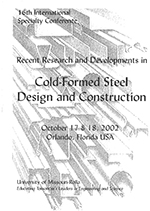Session Dates
17 Oct 2002
Abstract
Cold-formed C channel sections have been used in portal frame construction for agricultural sheds for many years in Australia. The knee joint designs have been copied from hot-rolled portal frames, regardless of the fact that many designers believe this is not realistic. Earlier testing conducted at the University of South Australia demonstrated that these concerns were justified and that the joint designs widely used in practice do not match the moment capacity of the sections and fail prematurely. An alternative joint design has been developed using self- drilling screws. The joint demonstrates excellent moment capacity and rigidity, and is simple to design. A similar joint has also been examined for the ridge connections, which are at a lower angle than the knee joints. This paper describes the development and testing of the self-drilling screw joints, as well as summarising testing of the conventional joints.
Department(s)
Civil, Architectural and Environmental Engineering
Research Center/Lab(s)
Wei-Wen Yu Center for Cold-Formed Steel Structures
Meeting Name
16th International Specialty Conference on Cold-Formed Steel Structures
Publisher
University of Missouri--Rolla
Document Version
Final Version
Rights
© 2002 University of Missouri--Rolla, All rights reserved.
Document Type
Article - Conference proceedings
File Type
text
Language
English
Recommended Citation
Mills, Julie and Laboube, Roger A., "Self-drilling Screw Joints for Cold-formed Channel Portal Frames" (2002). CCFSS Proceedings of International Specialty Conference on Cold-Formed Steel Structures (1971 - 2018). 4.
https://scholarsmine.mst.edu/isccss/16iccfss/16iccfss-session10/4
Self-drilling Screw Joints for Cold-formed Channel Portal Frames
Cold-formed C channel sections have been used in portal frame construction for agricultural sheds for many years in Australia. The knee joint designs have been copied from hot-rolled portal frames, regardless of the fact that many designers believe this is not realistic. Earlier testing conducted at the University of South Australia demonstrated that these concerns were justified and that the joint designs widely used in practice do not match the moment capacity of the sections and fail prematurely. An alternative joint design has been developed using self- drilling screws. The joint demonstrates excellent moment capacity and rigidity, and is simple to design. A similar joint has also been examined for the ridge connections, which are at a lower angle than the knee joints. This paper describes the development and testing of the self-drilling screw joints, as well as summarising testing of the conventional joints.



